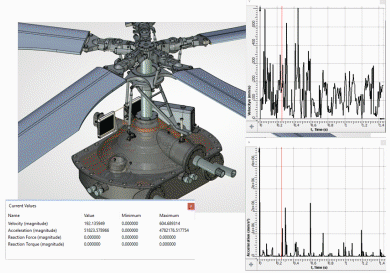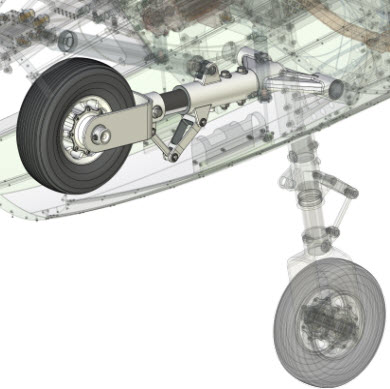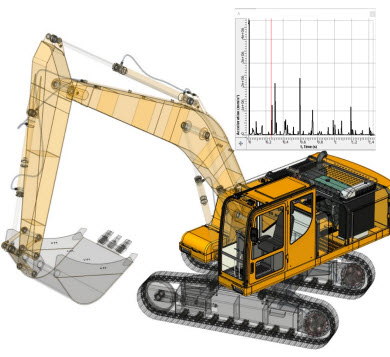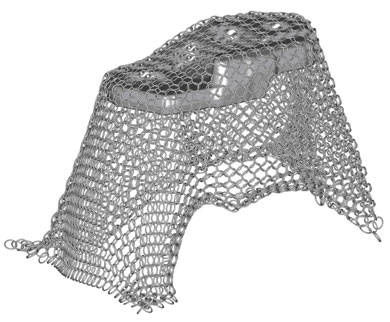General-purpose motion simulation for studying the physics-based motion behavior of a CAD design.
 T-FLEX Dynamics is a general-purpose motion simulation add-on application for studying the physics-based motion behavior of a CAD design without leaving the T-FLEX CAD environment.
T-FLEX Dynamics is a general-purpose motion simulation add-on application for studying the physics-based motion behavior of a CAD design without leaving the T-FLEX CAD environment.
Behavior of Mechanical Assemblies
When designing a mechanical system such as an automotive suspension or an aircraft landing gear, you need to understand how various components (pneumatics, hydraulics, electronics, and so on) interact as well as what forces those components generate during operation. T-FLEX Dynamics is a motion simulation solution for analyzing the complex behavior of mechanical assemblies. T-FLEX Dynamics allows you design and simulate moving assemblies so that you can find and correct design mistakes, test virtual prototypes and optimize designs for performance, safety, and comfort, without having to build and test numerous physical prototypes. Fewer physical prototypes, not only cuts costs, but also reduces time to market, giving you a better quality product, that is built right the first time.
Physics-based Models Associated to Engineering Conditions

Industry Application
By combining physics-based motion with assembly information from T-FLEX CAD, T-FLEX Dynamics can be used in a broad span of industry application like analyzing control systems, such as hydraulics, electronics, pneumatics; understanding robotics performance during operation; optimizing or minimizing the force imbalances in rotating systems; understanding gear drives; simulating realistic motion and loads of suspension systems; evaluating the dynamic behavior of space assemblies, such as launchers and satellites; optimizing consumer and business electronics; predicting component and system loads for fatigue, noise or vibration; etc.
Reviewing Results
 After simulating an assembly, you have a variety of results visualization tools in the form of XY graphs or numerical data of displacements, velocities, accelerations, force vectors at joint locations, displaying a trace on any point of the body during the entire simulation, etc. Special "pair of bodies" sensor measures reaction forces and friction in the contact point. You can animate your mechanism during or immediately following a simulation. Using animations and XY graphs inside T-FLEX software you can size motors/actuators, determine power consumption, layout linkages, develop cams, size springs/dampers, and determine how contacting parts behave. Synchronized graphing and animation directly associate force and acceleration values with mechanism positions. T-FLEX Dynamics also calculates loads that can be used to define load cases for structural analyses.
After simulating an assembly, you have a variety of results visualization tools in the form of XY graphs or numerical data of displacements, velocities, accelerations, force vectors at joint locations, displaying a trace on any point of the body during the entire simulation, etc. Special "pair of bodies" sensor measures reaction forces and friction in the contact point. You can animate your mechanism during or immediately following a simulation. Using animations and XY graphs inside T-FLEX software you can size motors/actuators, determine power consumption, layout linkages, develop cams, size springs/dampers, and determine how contacting parts behave. Synchronized graphing and animation directly associate force and acceleration values with mechanism positions. T-FLEX Dynamics also calculates loads that can be used to define load cases for structural analyses.
User Interface
Fast and Accurate Handling of Large Models
Fast and Accurate Handling of Large Models Today, the use of large prototype models in industrial development processes depends on the efficiency and speed of the way such large models are handled. With its effective solving techniques and advanced data manipulation, T-FLEX Dynamics is perfectly capable of processing large-size models. The algorithms implemented in the solver are optimized to provide the right accuracy and to deliver results fast.
Express Dynamics in T-FLEX CAD
 Express Dynamics, a limited version of
Express Dynamics, a limited version of
T-FLEX Dynamics Benefits
- Create more innovative products by using the time savings gained from virtual testing to evaluate more design ideas.
- Identify and optimize the parameters that have most impact on the real-life performance of a design.
- Dimension motors and actuators by computing the forces and torques needed to generate desired mechanism motion.
- Work in a secure virtual environment, without the fear of losing critical data due to instrument failure or of falling behind schedule due to poor weather conditions, common elements that accompany real-world testing.
- Reduce risk by getting better design information at every stage of the development process.
- Analyze design changes much faster and at a lower cost than physical prototype testing requires.
- Improve product quality by exploring numerous design variations in order to optimize full-system performance.
- Vary the kinds of analyses being performed without having to modify physical instrumentation, test fixtures, and test procedures.

